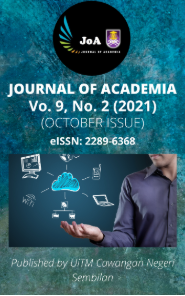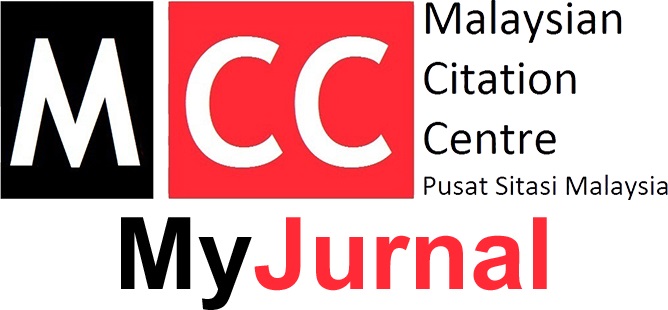PHYTOCHEMICAL EVALUATION AND ANTIMICROBIAL ACTIVITY OF SELECTED PIGMENTED PLANTS: Garcinia mangostana, Clitoria ternatea, Ardisia colorata var elliptica and Syzygium cumini
Keywords:
anthocyanin, antimicrobial activity, LC-MS Q-TOF, phytochemical, pigmented plantAbstract
In recent years, the application of plant extract as natural antimicrobial and colourants in food are
gaining interest, concurrently with the increasing reports and consumer awareness on the adverse effect
of the synthetic ones. Hence, the objectives of this study were to evaluate the phytochemicals and
antimicrobial activity of the selected pigmented plants namely, Garcinia mangostana peel, Clitoria
ternatea flower, Ardisia colorata var elliptica fruit and Syzygium cumini fruit. The phytochemicals
present in the selected pigmented plants were determined based on the phytochemical screening and
liquid chromatography mass spectrometry quadrupole time-of-flight (LC-MS Q-TOF), while
antimicrobial activity analysis was carried out using the disc diffusion technique. Phytochemical
screening revealed that Garcinia mangostana exhibited the strongest indications for the presence of
flavonoid, leucoanthocyanidin, quinone, tannin and anthocyanidin than other pigmented plants studied.
Three anthocyanin namely, delphinidin-3-O-glucoside, delphinidin-3-O-galactoside and malvidin-3-O
galactoside was first time identified in A. colorata by LC-MS Q-TOF. The antimicrobial activity
analysis showed that, Garcinia mangostana peel exhibited the strongest inhibition on fungi Aspergillus
niger and gram-positive bacteria i.e. Bacillus cereus, Bacillus subtilis and Staphylococcus aureus with
minimum inhibitory zone of 6.50, 8.50, 6.70, and 7.20 mm, respectively. Therefore, our results
suggested that the antimicrobial activity of Garcinia mangostana peel was associated with their specific
phenolic compounds. From a practical point of view, Garcinia mangostana peel may be a good
candidate for functional foods and pharmaceutical applications.
References
Abuzaid, A. S., Sukandar, E. Y., Kurniati, N. F., & Adnyana, I. K. (2018). Antihyperlidemic effects of mangosteen
(Garcinia mangostana L.) pericarp ethanolic extract in high-carbohydrate wistar rats. Journal of Natural
Remedies, 17(4), 165-173.
Aires, A. (2017). Phenolics in foods: extraction, analysis and measurements. Phenolic Compounds, 61-88.
Arnold, L. E., Lofthouse, N., & Hurt, E. (2012). Artificial Food Colors and Attention-Deficit/Hyperactivity
Symptoms: Conclusions to Dye for. Neurotherapeutics, 9(3), 599-609. doi:10.1007/s13311-012-0133-x
Ayoola, G. A., Coker, H. A., Adesegun, S. A., Adepoju-Bello, A. A., Obaweya, K., Ezennia, E., & Atangbayila, T.
(2008). Phytochemical Screening and Antioxidant Activities of Some Selected Medicinal Plants Used for Malaria
Therapy in Southwestern Nigeria. Tropical Journal of Pharmaceutical Research, 7 (3), 1019-1024.
doi:http://dx.doi.org/10.4314/tjpr.v7i3.14686
Ayyanar, M., Subash-Babu, P., & Ignacimuthu, S. (2013). Syzygium cumini (L.) Skeels., a novel therapeutic agent
for diabetes: Folk medicinal and pharmacological evidences. Complementary Therapies in Medicine, 21(3), 232
doi:http://dx.doi.org/10.1016/j.ctim.2013.03.004
Bernal, J., Mendiola, J. A., Ibáñez, E., & Cifuentes, A. (2011). Advanced analysis of nutraceuticals. Journal of
Pharmaceutical and Biomedical Analysis, 55(4), 758-774. doi:http://dx.doi.org/10.1016/j.jpba.2010.11.033
Biswas, P., Yadav, R., & Bose, D. (2020). Non-permitted food colorants induced neurobehavioral toxicity in
cerebellum of rats. Parkinsonism & Related Disorders, 79, e118-e119.
Cheynier, V. (2012). Phenolic compounds: From plants to foods. Phytochemistry Reviews, 11(2), 153-177.
doi:10.1007/s11101-012-9242-8
Cooke, D. N., Thomasset, S., Boocock, D. J., Schwarz, M., Winterhalter, P., Steward, W. P., Gescher, A. J., &
Marczylo, T. H. (2006). Development of analyses by high-performance liquid chromatography and liquid
chromatography/tandem mass spectrometry of bilberry (Vaccinium myrtilus) anthocyanins in human plasma and
urine. Journal of Agricultural and Food Chemistry, 54(19), 7009-7013.
Cox, C., & Ebo, D. (2012). Carmine red (E-120)-induced occupational respiratory allergy in a screen-printing
worker: A case report. B-ENT, 8(3), 229.
Delgado-Vargas, F., & Paredes-López, O. (2003). Natural pigments - Global perspective. In Natural colorants for
food and nutraceutical uses. Boca Raton, USA: CRC Press. pp.16.
Faria, A. F., Marques, M. C., & Mercadante, A. Z. (2011). Identification of bioactive compounds from jambolão
(Syzygium cumini) and antioxidant capacity evaluation in different pH conditions. Food Chemistry, 126(4), 1571
doi:http://dx.doi.org/10.1016/j.foodchem.2010.12.007
Ferrara, L., Schettino, O., Forgione, P., Rullo, V., & Di Gennaro, S. (1989). Identification of the root of Punica
granatum in galenic preparations using TLC. Bollettino della Societa italiana di biologia sperimentale, 65(5),
-390.
Fu, C., Loo, A. E. K., Chia, F. P. P., & Huang, D. (2007). Oligomeric proanthocyanidins from mangosteen pericarps.
J. of Agricultural and Food Chemistry, 55(19), 7689-7694.
Geetha, R. V., Anitha, R. O. Y., & Lakshmi, T. (2011). Evaluation of anti bacterial activity of fruit rind extract of
Garcinia mangostana Linn on enteric pathogens-an in vitro study. Asian Journal of Pharmaceutical and Clinical
Research, 4, 115-118.
Guerrero, T. E., Vejarano, P., Paredes, J. L., & Cépeda, R. (2012). Phytochemical screening and quantification of
total flavonoids of canned white asparagus (Asparagus officinalis). Acta Horticulturae (ISHS), 950, 241-245.
Husain, N. H. (2014). Laksam warna warni pikat pelanggan. Sinar Harian. Retrieved from
Hussin, M. H. (2015). Roti canai ‘pelangi’. Harian Metro, p. 1. Retrieved from http://www.hmetro.com.my
Iloki-Assanga, S. B., Lewis-Luján, L. M., Lara-Espinoza, C. L., Gil-Salido, A. A., Fernandez-Angulo, D., Rubio
Pino, J. L., & Haines, D. D. (2015). Solvent effects on phytochemical constituent profiles and antioxidant activities,
using four different extraction formulations for analysis of Bucida buceras L. and Phoradendron californicum.
BMC Research Notes, 8(1), 1-14.
Imeh, U., & Khokhar, S. (2002). Distribution of conjugated and free phenols in fruits: antioxidant activity and
cultivar variations. Journal of Agricultural and Food Chemistry, 50(22), 6301-6306.
Jampani, C., Naik, A., & Raghavarao, K. (2014). Purification of anthocyanins from jamun (Syzygium cumini L.)
employing adsorption. Separation and Purification Technology, 125, 170-178.
Joaquín-Cruz, E., Dueñas, M., García-Cruz, L., Salinas-Moreno, Y., Santos-Buelga, C., & García-Salinas, C.
(2015). Anthocyanin and phenolic characterization, chemical composition and antioxidant activity of chagalapoli
(Ardisia compressa K.) fruit: A tropical source of natural pigments. Food Research International, 70, 151-157.
Kazuma, K., Noda, N., & Suzuki, M. (2003a). Flavonoid composition related to petal color in different lines of
Clitoria ternatea. Phytochemistry, 64(6), 1133-1139. doi:http://dx.doi.org/10.1016/S0031-9422(03)00504-1
Kazuma, K., Noda, N., & Suzuki, M. (2003b). Malonylated flavonol glycosides from the petals of Clitoria ternatea.
Phytochemistry, 62(2), 229-237. doi:http://dx.doi.org/10.1016/S0031-9422(02)00486-7
Li, D., Meng, X., & Li, B. (2016). Profiling of anthocyanins from blueberries produced in China using HPLC
DAD-MS and exploratory analysis by principal component analysis. Journal of Food Composition and Analysis,
, 1-7.
Magnusson, O. T., Toyama, H., Saeki, M., Rojas, A., Reed, J. C., Liddington, R. C., Klinman, J. P., &
Schwarzenbacher, R. (2004). Quinone biogenesis: structure and mechanism of PqqC, the final catalyst in the
production of pyrroloquinoline quinone. Proceedings of the National Academy of Sciences, 101(21), 7913-7918.
Mahesh, B., & Satish, S. (2008). Antimicrobial activity of some important medicinal plant against plant and human
pathogens. World Journal of Agricultural Sciences, 4(5), 839-843.
Maksimović, Z., Malenčić, Đ., & Kovačević, N. (2005). Polyphenol contents and antioxidant activity of Maydis
stigma extracts. Bioresource Technology, 96(8), 873-877.
Malenčić, D., Maksimović, Z., Popović, M., & Miladinović, J. (2008). Polyphenol contents and antioxidant
activity of soybean seed extracts. Bioresource Technology, 99(14), 6688-6691.
Mamtha, B., Kavitha, K., Srinivasan, K., & Shivananda, P. (2004). An in vitro study of the effect of Centella
asiatica [Indian pennywort] on enteric pathogens. Indian Journal of Pharmacology, 36(1), 41.
Manimekalai, I., Sivakumari, K., Ashok, K., & Rajesh, S. (2016). Phytochemical profiling of mangosteen fruit,
Garcinia mangostana. World J Pharm Pharm Sci, 5(2), 221-52.
Mathew, N., Anitha, M., Bala, T., Sivakumar, S., Narmadha, R., & Kalyanasundaram, M. (2009). Larvicidal
activity of Saraca indica, Nyctanthes arbor-tristis, and Clitoria ternatea extracts against three mosquito vector
species. Parasitology research, 104(5), 1017-1025.
McCann, D., Barrett, A., Cooper, A., Crumpler, D., Dalen, L., Grimshaw, K., Kitchin, E., Lok, K., Porteous, L.,
Prince, E., Sonuga-Barke, E., Warner MD, J. O., & Stevenson, J. (2007). Food additives and hyperactive behaviour
in 3-year-old and 8/9-year-old children in the community: a randomised, double-blinded, placebo-controlled trial.
Lancet, 370(9598), 1560-1567. doi:10.1016/S0140-6736(07)61306-3
from
the
Mohamed, G. A., Ibrahim, S. R. M., Shaaban, M. I. A., & Ross, S. A. (2014). Mangostana xanthones I and II, new
xanthones
pericarp
of
doi:http://dx.doi.org/10.1016/j.fitote.2014.08.014
Garcinia
mangostana.
Fitoterapia,
,
-221.
Nair, V., Bang, W. Y., Schreckinger, E., Andarwulan, N., & Cisneros-Zevallos, L. (2015). Protective role of ternatin
anthocyanins and quercetin glycosides from butterfly pea (Clitoria ternatea Leguminosae) blue flower petals
against lipopolysaccharide (LPS)-induced inflammation in macrophage cells. Journal of Agricultural and Food
Chemistry, 63(28), 6355-6365.
Nakajima, J.-i., Tanaka, Y., Yamazaki, M., & Saito, K. (2001). Reaction mechanism from leucoanthocyanidin to
anthocyanidin 3-glucoside, a key reaction for coloring in anthocyanin biosynthesis. Journal of Biological
Chemistry, 276(28), 25797-25803.
Ogawa, H., & Natori, S. (1968). Hydroxybenzoquinones from Myrsinaceae plants. III. The structures of 2
hydroxy-5-methoxy-3-pentadecenylbenzoquinone and Ardisiaquinones A, B and C from Ardisia spp. Chemical
and Pharmaceutical Bulletin, 16(9), 1709-1720.
Okamura, H., Mimura, A., Yakou, Y., Niwano, M., & Takahara, Y. (1993). Antioxidant activity of tannins and
flavonoids in Eucalyptus rostrata. Phytochemistry, 33(3), 557-561. doi:10.1016/0031-9422(93)85448-z
Palakawong, C., Sophanodora, P., Toivonen, P., & Delaquis, P. (2013). Optimized extraction and characterization
of antimicrobial phenolic compounds from mangosteen (Garcinia mangostana L.) cultivation and processing
waste. Journal of the Science of Food and Agriculture, 93(15), 3792-3800. doi:10.1002/jsfa.6277
Palapol, Y., Ketsa, S., Stevenson, D., Cooney, J. M., Allan, A. C., & Ferguson, I. B. (2009). Colour development
and quality of mangosteen (Garcinia mangostana L.) fruit during ripening and after harvest. Postharvest Biology
and Technology, 51(3), 349-353. doi:http://dx.doi.org/10.1016/j.postharvbio.2008.08.003
Phatthalung, P. N., Chusri, S., & Voravuthikunchai, S. P. (2012). Thai ethnomedicinal plants as resistant modifying
agents for combating Acinetobacter baumannii infections. BMC Complementary and Alternative Medicine, 12(1),
-8.
Pintea, A. M. (2007). Other Natural Pigments. In C. Socaciu (Ed.), Food Colorants: Chemical and Functional
Properties (1st ed.). Boca Raton, US: CRC Press. pp. 26.
Pradipta, I. S., Nikodemus, T. W., & Susilawati, Y. (2007). Isolasi dan Identifikasi Senyawa Golongan Xanton dari
Kulit Buah Manggis (Garcinia mangostana L.). Jurnal Ilmiah Farmasi, 4(2).
Priya, S. S. L., Devi, P. R., Eganathan, P., & Kingsley, J. (2013). In vitro antimicrobial activity of Syzygium cumini
fruit peel and identification of anthocyanins. African Journal of Pharmacy and Pharmacology, 7(25), 1719-1728.
Rastogi, N., Domadia, P., Shetty, S., & Dasgupta, D. (2008). Screening of natural phenolic compounds for
potential to inhibit bacterial cell division protein FtsZ. Indian Journal of Experimental Biology, 46 783-787.
Rauha, J.-P., Remes, S., Heinonen, M., Hopia, A., Kähkönen, M., Kujala, T., Pihlaja, K., Vuorela, H., & Vuorela,
P. (2000). Antimicrobial effects of Finnish plant extracts containing flavonoids and other phenolic compounds.
International Journal of Food Microbiology, 56(1), 3-12. doi:https://doi.org/10.1016/S0168-1605(00)00218-X
Reddy, A. M., Reddy, V. S., Scheffler, B. E., Wienand, U., & Reddy, A. R. (2007). Novel transgenic rice
overexpressing anthocyanidin synthase accumulates a mixture of flavonoids leading to an increased antioxidant
potential. Metabolic engineering, 9(1), 95-111.
Rucker, R., Stites, T., Steinberg, F., & Mitchell, A. (2000). Physiological importance of pyrroloquinoline quinone.
Paper presented at the Biochemistry and Molecular Biology of Vitamin B6 and Pqq-Dependent Proteins.
Samichu, R. S. (Writer). (2016). Laksa Pelangi. In P. Studio (Producer), Nasi Lemak Kopi O. Malaysia.
Singh, J. P., Kaur, A., Singh, N., Nim, L., Shevkani, K., Kaur, H., & Arora, D. S. (2016). In vitro antioxidant and
antimicrobial properties of jambolan (Syzygium cumini) fruit polyphenols. LWT - Food Science and Technology,
, 1025-1030. doi:http://dx.doi.org/10.1016/j.lwt.2015.09.038
Siti Azima, A. M., Noriham, A., & Manshoor, N. (2017). Phenolics, antioxidants and color properties of aqueous
pigmented plant extracts: Ardisia colorata var. elliptica, Clitoria ternatea, Garcinia mangostana and Syzygium
cumini. Journal of Functional Foods, 38, 232-241. doi:https://doi.org/10.1016/j.jff.2017.09.018
Suttirak, W., & Manurakchinakorn, S. (2014). In vitro antioxidant properties of mangosteen peel extract. Journal
of Food Science and Technology, 51(12), 3546-3558. doi:10.1007/s13197-012-0887-5
Syed, E., Mashroor, B., Hossain, F. M. D., Bi-Illah, N., Bhattacharjee, R., & Hannan, J. (2013). Evaluation of
phytochemical screening and antimicrobial activities of Ethanolic extracts of leaves and bark of Ardisia colorata.
International Journal of Pharmaceutical and Life Sciences, 2(4), 158-164.
Tavarini, S., Degl’Innocenti, E., Remorini, D., Massai, R., & Guidi, L. (2008). Antioxidant capacity, ascorbic acid,
total phenols and carotenoids changes during harvest and after storage of Hayward kiwifruit. Food Chemistry,
(1), 282-288.
Uma, B., Prabhakar, K., & Rajendran, S. (2009). Phytochemical analysis and antimicrobial activity of Clitorea
ternatea Linn against extended spectrum beta lactamase producing enteric and urinary pathogens. Asian Journal
of Pharmaceutical and Clinical Research, 2, 94-96.
Veigas, J. M., Narayan, M. S., Laxman, P. M., & Neelwarne, B. (2007). Chemical nature, stability and bioefficacies
of anthocyanins from fruit peel of syzygium cumini Skeels. Food Chemistry, 105(2), 619-627.
doi:http://dx.doi.org/10.1016/j.foodchem.2007.04.022
Wang, Y., Li, B., Meng, X., An, X., Ma, Y., Zhang, Q., Li, L., & Li, D. (2016). Effect of in vitro simulated digestion
on anthocyanin composition and antioxidant activity of Lonicera caerulea berry extracts. Food Science, 2016, 19.
Yang, L.-K., Khoo-Beattie, C., Goh, K.-L., Chng, B.-L., Yoganathan, K., Lai, Y.-H., & Butler, M. S. (2001).
Ardisiaquinones from Ardisia teysmanniana. Phytochemistry, 58(8), 1235-1238.
Zarena, A. S., Manohar, B., & Sankar, K. U. (2012). Optimization of supercritical carbon dioxide extraction of
xanthones from mangosteen pericarp by response surface methodology. Food and Bioprocess Technology, 5(4),
-1188.
Zarena, A. S., & Sankar, K. U. (2012). Isolation and identification of pelargonidin 3-glucoside in mangosteen
pericarp. Food Chemistry, 130(3), 665-670. doi:http://dx.doi.org/10.1016/j.foodchem.2011.07.106
Zhang, L. L., & Lin, Y. M. (2009). Antioxidant tannins from Syzygium cumini fruit. African Journal of
Biotechnology, 8(10), 2301-2309.
Downloads
Published
Issue
Section
License
Copyright (c) 2021 Journal of Academia

This work is licensed under a Creative Commons Attribution-NonCommercial-NoDerivatives 4.0 International License.












